|
I'm watching a man play music with his butt. When I woke up this morning, I had no idea my day would end like this. We the hushed crowd examine the large projection before us. Dani Ploegar stands naked and proud on a blue-tiled floor, his back turned towards us, the top half of his body cast mysteriously in silhouette whilst a soft, gold-tinted light frosts his legs and muscular buttocks. In his butt he has secreted an Anuform anal electrode, and falling away from that hidden egg is a long cable connected to a modified Peritone EMG sensor. These commercial medical devices were developed to treat incontinence by enabling users to exercise their rectal muscles. But Dani is using them for art. He is working his sphincter to a specific beat, performing an extremely rare combination of falsehood and carnal pleasure. For he is faking a male orgasm, clenching his muscles to mimic the rhythmic contractions of pleasure, which Anuform and Peritone channel into a synthesiser to produce digital sound. Whooping wails and musical howls warble out from the sound generator, the sound of alien tentacles mopping a floor of microphones, an electronic heavenly chorus in grief. His performance, Electrode (2011), is unlike anything I've ever seen, heard, or considered before. But how does he know how to move his butt? Dani is actually replicating a recorded sphincter contraction pattern from an anonymous male subject, who duly masturbated himself to orgasm as part of a 1980s study. Dani, a performance artist and lecturer at the Central School of Speech and Drama, subverts the scientific data and devices into something new and unforgettable.  It's so bizarre that we are all quietly awestruck. And I love Dani's earnest and serious delivery as the man himself talks to us here at the Waag Society in Amsterdam, a public institute to explore science, art and technology. It's another pleasant and crowded Do-It-Together Workshop, and tonight's topic is Neuro Cyborg. Now that the bizarre has truly been crossed, there is nothing else to do but lean back and appreciate the art. I've already done my bit earlier this evening. I made an insect biomechatronic. 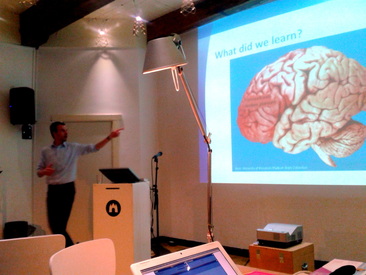 The evening had begun with a quick introduction to brain imaging by Martijn Steenwijk, PhD student at VU University Medical Center. Martijn, a specialist in medical imaging of the brain, explained some of the technology used today to look into the brain's activities. It seems to me, naive 80's child, that imaging technologies have been used for years to peer into the brain. The images are still fuzzy and no one can be quite definite what an area of brightly lit activity really signifies. But bit by bit, there is more to be said from the pictures, because there are more ways to string the data together. While working for the European Grid Infrastructure I have learned about the development of The Human Brain project, a virtual brain that will be built using colossal computing power and data from thousands of brain scans. It is clear that supercomputing is the crucial tool to tell us more about the brain by building a working simulation of nerve impulses, not just new scanning technologies to read the brain's shape and activities. 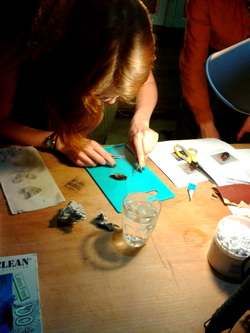 Next we had the opportunity to explore neuroscience ourselves, using the Do-It-Yourself kits of Backyard Brains. Backyard Brains are a start-up group of scientists and engineers, who have created a variety of mini-science kits for students and DIY Biology enthusiasts. The kits can be ordered online and aim to deliver 'Neuroscience for Everyone'. You can, for instance, order a 'Spikerbox' to listen to nerve impulses or make a cockroach leg twitch in time to an iPod track. You can also create a 'RoboRoach', a $10,000 project that was funded through Kickstarter, which lets you control a cockroach with mobile phone. To make a RoboRoach, you essentially have to cut some bits off a living cockroach and connect its body to some small circuitry and wiring which will convey electric impulses to the roach's nerves. The fact that the cockroaches don't feel pain provides a sop to any uneasy feelings an experimenter might have about doing this, but the concept remains somewhat unpleasant- and so it should. Nobody should experiment with animal models lightly. The launch of the RoboRoach kit generated controversy, and the creators responded to it. “I try not to downplay the fact that in science we use animal models and a lot of times they are killed,” said Greg Gage, one of the co-founders of Backyard Brains. He also points out that the kits teach about the care procedures of scientific animal models. How to anaesthetise the animal, and how to minimise damage from wounds. And when to retire a model to live out its life, or perhaps, be euthanised. Still, Gage acknowledges, “we get a lot of e-mails telling us we’re teaching kids to be psychopaths.” And a quick google shows me plenty of critical news reports lambasting the RoboRoach. Though I see similar arguments employed in each one - the 'wrong people using the wrong treatment', the slippery slopes of 'roach today, human tomorrow', the general unease of making live animal experimentation into a commodity, even if it is a learning tool. The condensed version is this: if you make these kits available to anyone then someone is going to abuse the science. It's the same popular argument deployed against citizen science, biohacking, and DIY Biology movements. While I don't want to dismiss it out of hand, I do think it obvious that with a few replaced words, that dire warning becomes applicable to any field. If you would like to decide for yourself, you can start by watching Greg Gage's TED talk on the RoboRoach, replete with a live demo.  As the talk finished and the practical part of the night began, I found myself at a table with a Spikerbox and a small tank of roaches. We were to cut off a roach leg and use it to listen to nerve impulse 'spikes' using with a neuron amplifier. Someone fished out a roach and dropped it in ice water to knock it out. I shared nervous grins with the others. Who was going to be wielding the scalpel? 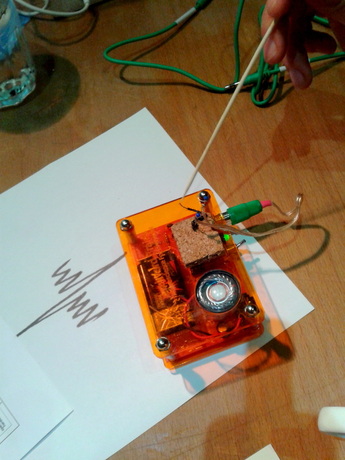 I found myself volunteering. First, I found I wasn't squeamish - I was interested in the science. Second, having handled scalpels and done dissections before, I wanted the responsibility of looking after the roach. Stunned by the ice water, it wasn't going to feel a thing, and provided I cut it in the right place, its only injury would be one missing leg which would grow back within a few weeks. I donned my gloves, picked up a scalpel and zoomed in on the unconscious roach. A few motions, then the roach was put back into the tank to wake up. I hoped that tank life was easy enough to outweigh any living difficulties it might encounter, with one less leg. We then secured the two Spikerbox electrodes into the neuron running through the leg, and plugged the Spikerbox into a smartphone with the Spikerbox app. Manipulating the hairs on the leg tip sent an electric nerve impulse rushing up the limb and past the other embedded electrode, resulting in a crackling and visible spiking depicted on the smartphone. And it really was amazing, to hear a nerve impulse and see it dance upon the screen. We living, conscious beings were all standing around marvelling at simple roach leg nerve impulse thanks to millions of impossibly complex nerve impulses firing in us so we could do the marvelling... but it was the simple roach leg set-up that truly summed up the power of nerve impulses. We jostled for the toothpick to touch the leg, and hear the sound of neurochemistry.  Over on the RoboRoach table, they weren't faring so well at attaching the necessary parts to the roach. Unfortunately, that was one experiment that we didn't get to see. Elsewhere, another table used a Spikerbox to measure human nerve impulses, and then Dani delivered his talk on his sphincter music. After Dani, the final artist was Arthur Elsenaar, presenting Artificial Facial Expression, or Artifacial- a bizarre series of computer-controlled human expressions. Instead of sending bodily nerve signals to an electronic device, like Dani, Arthur inverted this pathway by letting a computer program control his facial muscles. Little electrical impulses are delivered to electrodes patched onto his face and generate a slew of grimaces and twitches. I stared and wondered what on earth this particular juxtaposition of control, electronics and living flesh heralds for our future. I had never considered that we might voluntarily allow robots and electronics to control us, rather than we control them. Then again, isn't deep brain stimulation via electrodes already a pioneering treatment for Parkinson's disease? But what about robotic science and artistic performance? Actually, as Arthur could tell you himself, electronic body performance dates back to the 18th century. 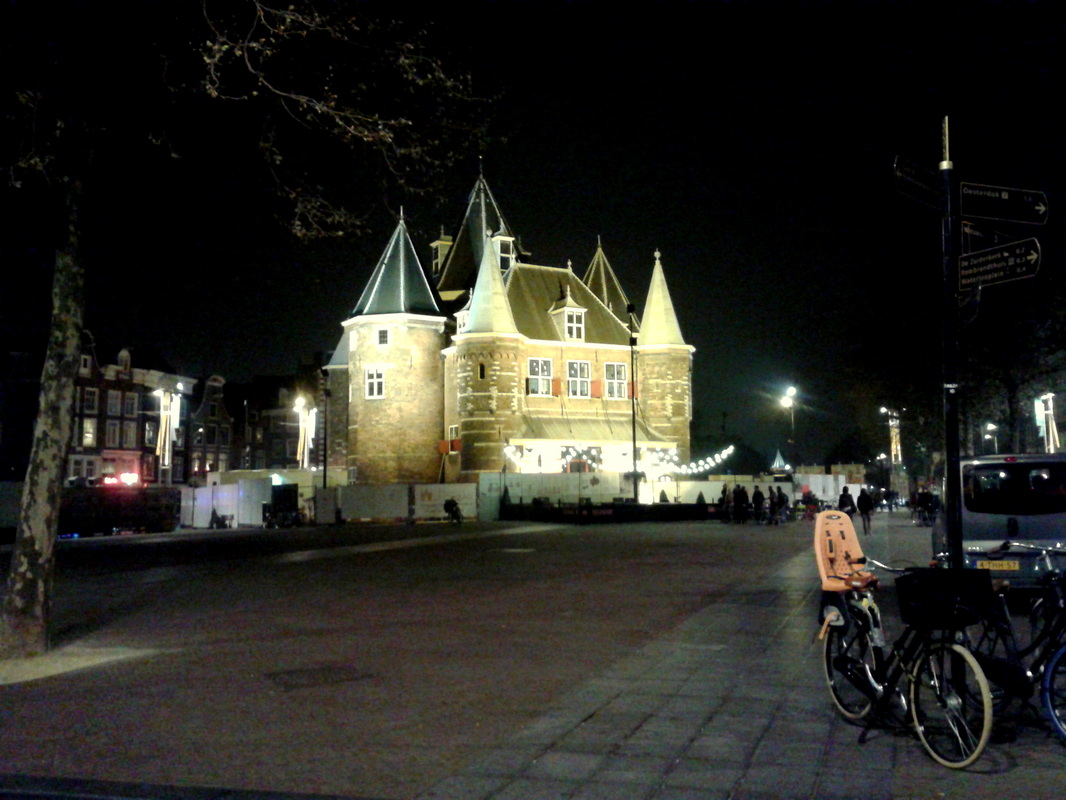 Later on, I cycled back home through the dark streets of Amsterdam. I was thinking, variously, of a cockroach leg, a musical butt, and a computer's face.
0 Comments
|
AuthorNot quite a blog, but things that I have written. Please note - these writings are unedited, for the purposes of flexing my fingers, and no doubt contain grammatical errors and carelessness of expression I wouldn't allow in professional writing. Categories
All
Archives
June 2021
|


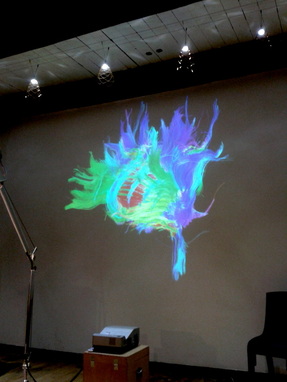
 RSS Feed
RSS Feed
